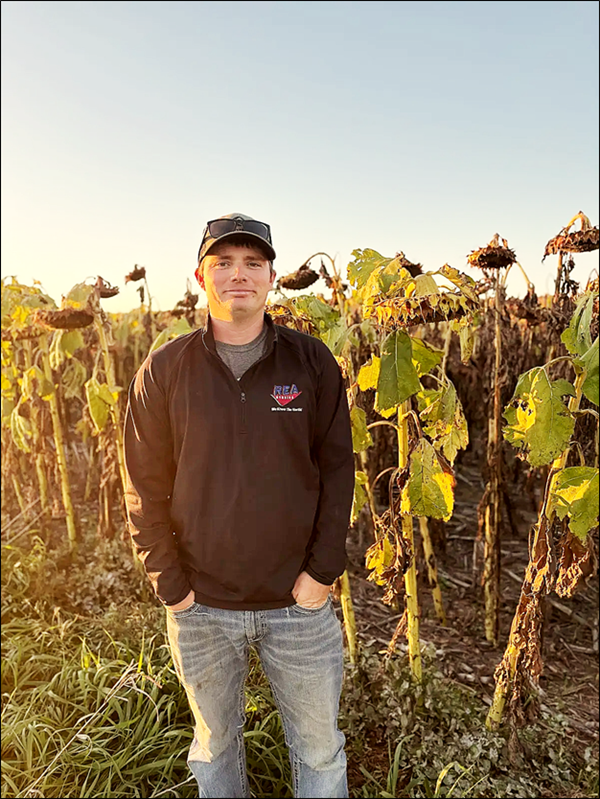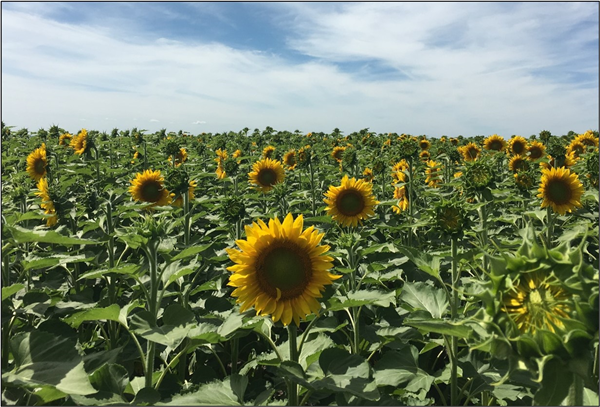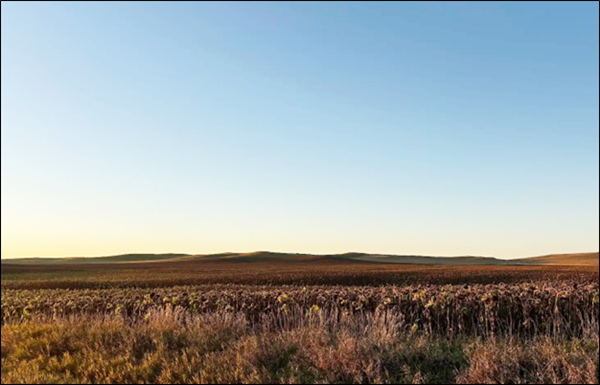| Bo Beer Discusses Sunflower’s Fit on His Family’s Northwestern South Dakota Farm |
 |
 |
Come early October, Bo Beer gets the itch to start harvesting sunflower.
“We like to harvest first week in October when the ’flowers are 10-12% moisture and the back of the head is still kind of green and mushy, but the seeds are dry. That cuts down on the dust and fires,” he explains.
The northwestern South Dakota farmer usually starts cutting sunflower in mid-October, but as of the first of the month, Beer was pretty sure this year will be a little later, thanks to Mother Nature.
Beer farms with his dad Mike near Keldron, S.D. Normal average precipitation from January to September is usually around 14 inches. This year, an estimated 22 inches of precip had been recorded through September.
“We had around nine inches of rain in mid-May in just 10 days, and it’s been steady ever since. We’ve received about 8-10 inches more than normal in some fields,” Beer reports. “We are pretty well saturated, and we’re even dealing with some drownout issues. Our soil is a heavy clay, and once it gets wet, it tends to stay wet.”
All that rain in May pushed planting back for the Beers in 2025.
“We can plant sunflower anytime from the middle of May until the end of June,” Beer notes. “Ideally, I’d like to plant the last week of May and the first week of June. That seems to be the right temperature to get the ’flowers up and out of the ground and growing. Also, the earlier we plant, the more oil content our ’flowers seem to have.”
The Beers often plant some later shorter-day varieties for bird food. This year, they have more of such acres than normal, because of the late plant date. They also have about 500 more acres of sunflower across the board this season; all that rain forced them to switch some fields they had slotted for corn over into sunflower.
Despite all the rain and the continually wet soil, this year’s Beer sunflower crop looked good as the season drew to an end.
The Beer rotation includes sunflower, corn, spring wheat, winter wheat, occasionally soybeans and then forage crops. “We also have about 700 cow calf pairs,” Bo adds.
Mike Beer has been tweaking that rotation for years. He switched to no till in the mid-1990s, and the crop rotation became more diversified after that. Bo recalls as a kid, the fields used to be all wheat, barley and oats. Now, they also encompass row crops like corn and sunflower.
Over the years, they’ve perfected the best way to plant those sunflower fields. They’ve learned that planting in 30-inch rows, 21,500 seeds/acre, provides the best results. The proof is in their yields — which consistently run in the 1,900- to 2,200-lb range.
Situated on the western edge of Corson County, the second-generation Beer farm is located on the Standing Rock Indian Reservation; and just as the reservation spans the border of North and South Dakota, so too does the Beer family farm. They farm about 8,500 acres spanning both sides of the border. Every year, about a quarter of those acres are in sunflower.
“Year in and year out, sunflower is the most profitable crop we have,” says Bo Beer. “They grow really well here, and the price is usually pretty good. They just seem to fit really well in the western Dakotas. We’re pretty dry, and sunflower is naturally drought tolerant. Their deep taproots work well with the nutrients that are available, and they just fit really well.”
Beer says high-oleic sunflower is a staple; but seed for bird food is always a part of the rotation, too. They market what they can to nearby elevators in Lemmon and McLaughlin, S.D. The rest goes to the ADM crushing plant at Enderlin, N.D. It’s nearly 300 miles from Keldron to Enderlin, making freight Beer’s biggest obstacle.
“Most sunflower ends up in Enderlin for crushing, but they don’t grow that many that far east anymore,” Beer observes. “I’d love to see the end users a little closer to the sunflower region, which seems to have shifted to the west. But I’m not sure that will happen.”
 |
|
The Beer farm in northwestern South Dakota’s Corson County counts on sunflower to come through both agronomically and economically across its broad landscape.
|
Beer always knew he wanted to join his dad on the farm someday. After high school, he earned a degree in farm and ranch management from Bismarck State College. He graduated in 2016 and has been farming full time alongside his dad ever since. He says that degree helped prepare him for some of the challenges that come with farming and ranching; he learned everything from financial and production kills, chemicals, building systems, farm maintenance, marketing and weed control.
He relies on that knowledge every day; but these days, insects and weeds are at the top of his list of sunflower-related problems to solve.
“Sunflower weevil has been a problem in central South Dakota, and we’re not that far away from it,” Beer says. “But our biggest concern right now is kochia. It’s getting harder and harder to control. We need to think outside the box to get that under control.”
He hopes research funded by the National Sunflower Association might help, too. In fact, he says research is just one of the important things he’s seen the NSA prioritize for growers like him.
“Sunflower is a big-time crop around here, but in the grand scheme of things, it’s really a smaller, specialty crop,” Beer says. “The NSA does good work with the money they have to help growers. From developing new hybrids and markets, it’s research that we definitely benefit from.” —Jody Kerzman